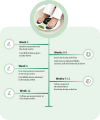Benefits of home-based foot neuromuscular electrical stimulation on self-reported function, leg pain and other leg symptoms among community-dwelling older adults: a sham-controlled randomised clinical trial
- PMID: 39143586
- PMCID: PMC11323382
- DOI: 10.1186/s12877-024-05271-z
Benefits of home-based foot neuromuscular electrical stimulation on self-reported function, leg pain and other leg symptoms among community-dwelling older adults: a sham-controlled randomised clinical trial
Abstract
Introduction: Lower leg pain and symptoms, and poor leg circulation are common in older adults. These can significantly affect their function and quality of life. Neuromuscular electrical stimulation (NMES) applied via the feet as 'foot NMES' activates the leg musculovenous pump. This study investigated the effects of foot NMES administered at home using Revitive® among community-dwelling older adults with lower leg pain and/or other lower leg symptoms such as cramps, or sensations of tired, aching, and heavy feeling legs.
Methods: A randomised placebo-controlled study with three groups (2 NMES, 1 Sham) and three assessments (baseline, week 8, week 12 follow-up) was carried out. Self-reported function using Canadian occupational performance measure (COPM), leg pain, overall leg symptoms score (heaviness, tiredness, aching, or cramps), and ankle blood flow were assessed. Analysis of covariance (ANCOVA) and logistic regression were used to compare the groups. Statistical significance was set at p < 0.05 (two-sided 5%).
Results: Out of 129 participants enrolled, 114 completed the study. The improvement in all outcomes were statistically significant for the NMES interventions compared to Sham at both week 8 (p < 0.01) and week 12 (p < 0.05). The improvement in COPM met the minimal clinically important difference (MCID) for the NMES interventions compared to Sham at both week 8 (p < 0.005) and week 12 (p < 0.05). Improvement in leg pain met MCID at week 8 compared to Sham (p < 0.05). Ankle blood flow increased approximately 3-fold during treatment compared to Sham. Compliance with the interventions was high and no device-related adverse events were reported.
Conclusions: The home-based foot NMES is safe, and significantly improved self-reported function, leg pain and overall leg symptoms, and increased ankle blood flow compared to a Sham among older adults.
Trial registration: The trial was prospectively registered in ISRCTN on 17/06/2019 with registration number ISRCTN10576209. It can be accessed at https://www.isrctn.com/ISRCTN10576209 .
Keywords: Blood flow; Leg pain; Leg symptoms; Neuromuscular electrical stimulation (NMES); Self-reported function.
© 2024. The Author(s).
Conflict of interest statement
The first author (BK) declares no competing interests. DT is an independent expert acting as a statistical consultant for Actegy Limited for this study (funder of the trial and manufacturer of Revitive®). TW has expert consultancy contract with Actegy Limited, which is unrelated to this study.
Figures
Similar articles
-
The effect of an 8-week treatment program using a novel foot neuromuscular electrical stimulator on physical function, leg pain, leg symptoms, and leg blood flow in community-dwelling older adults: a randomized sham-controlled trial.Trials. 2022 Oct 14;23(1):873. doi: 10.1186/s13063-022-06828-2. Trials. 2022. PMID: 36242050 Free PMC article. Clinical Trial.
-
Single-centre, double-blinded, randomised placebo-controlled trial to determine the effect of a 12-week home-based programme of footplate neuromuscular electrical stimulation on walking capacity in people with peripheral artery disease: a protocol for the Foot-PAD trial.BMJ Open. 2025 Jan 25;15(1):e093162. doi: 10.1136/bmjopen-2024-093162. BMJ Open. 2025. PMID: 39863411 Free PMC article.
-
Effects of combining electrical stimulation of the calf and thigh muscles in patients with osteoarthritis of the knee: protocol for a double-blind, randomised, sham-controlled trial.BMJ Open. 2022 Aug 25;12(8):e061113. doi: 10.1136/bmjopen-2022-061113. BMJ Open. 2022. PMID: 36008074 Free PMC article.
-
Interventions for leg cramps in pregnancy.Cochrane Database Syst Rev. 2020 Dec 4;12(12):CD010655. doi: 10.1002/14651858.CD010655.pub3. Cochrane Database Syst Rev. 2020. PMID: 33275278 Free PMC article.
-
Non-drug therapies for the secondary prevention of lower limb muscle cramps.Cochrane Database Syst Rev. 2021 May 17;5(5):CD008496. doi: 10.1002/14651858.CD008496.pub3. Cochrane Database Syst Rev. 2021. PMID: 33998664 Free PMC article.
References
-
- Puente-Fernández J, Larumbe-Zabala E, Jiménez A, Liguori G, Rossato CJL, Mayo X, et al. No impact of combining multi-ingredient supplementation with exercise on body composition and physical performance, in healthy middle-aged and older adults: a systematic review and meta-analysis. Exp Gerontol. 2023;172:112079. 10.1016/j.exger.2022.112079 - DOI - PubMed
-
- Gerhard-Herman MD, Gornik HL, Barrett C, Barshes NR, Corriere MA, Drachman DE, et al. 2016 AHA/ACC Guideline on the management of patients with Lower Extremity Peripheral Artery Disease: executive summary: a report of the American College of Cardiology/American Heart Association Task Force on Clinical Practice guidelines. Circulation. 2017;135(12):e686–725. - PMC - PubMed
-
- Criqui MH, Matsushita K, Aboyans V, Hess CN, Hicks CW, Kwan TW, et al. Lower extremity peripheral artery disease: contemporary epidemiology, management gaps, and future directions: A Scientific Statement from the American Heart Association. Circulation. 2021;144(9):e171–91. 10.1161/CIR.0000000000001005 - DOI - PMC - PubMed
Publication types
MeSH terms
LinkOut - more resources
Full Text Sources
Medical
Miscellaneous



